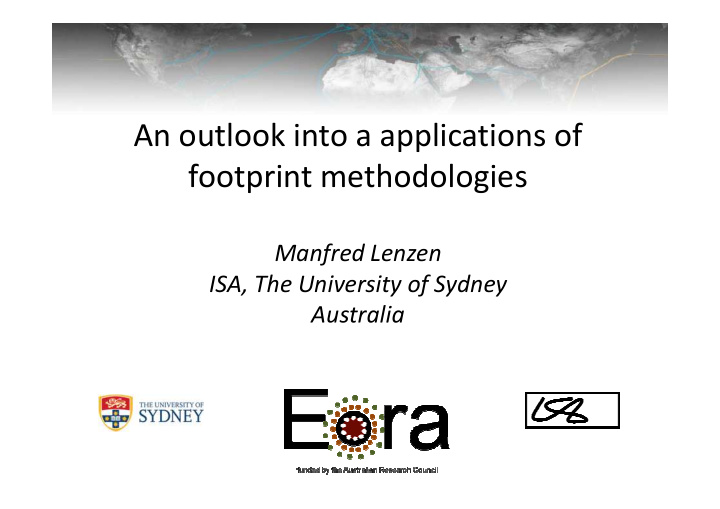



An outlook into a applications of footprint methodologies Manfred Lenzen Manfred Lenzen ISA, The University of Sydney Australia
Supply-chain analysis
Two examples in detail Overview & outlook
Example 1: Threatened species
Origins and Destinations of Australia’s species threats both “driven” overseas and “suffered” at home
Origins and Destinations of global species threats both “driven” overseas and “suffered” at home
High Impact Production Chains
High Impact Production Chains
Spider monkey (Ateles geoffroyi) Mexico and central America
High Impact Production Chains Round Whipray (Himantura pastinacoides)
Brown Cheeked Hornbill Ivory Coast Bycanistes cylindricus Jentink’s Duiker Cephalophus jentinkii Johnston’s Genet Genetta johnstoni
Consumers: What To Do ? • Know your labels and try to shop better • Recognise greenwash • Change procurement practices at work • Be country-aware and check origins • Investigate production chains
Example 2: Carbon footprint of the UK
Supply-chain analysis
Trend analysis
Uncertainty analysis
What other applications are possible ? possible ?
1. More indicators.
Carbon, land, water Nitrogen, air pollutants, phosphorus, NPP, water scarcity phosphorus, NPP, water scarcity Value added Employment, inequality, slavery, war casualties, occupational health
Trade in value added
Employment – global flows of labour Source: Alsamawi
Employment – the master-servant story Source: Alsamawi
Inequality Source: Alsamawi
Conflict Source: Moran & McBain
2. High geographical resolution.
The Sydney Environmental Atlas
Sydney: Transport energy 32
Sydney: Embodied energy 33
Sydney: Income structure 34
Energy requirement vs Income 35
The Sydney energy catchment 36
What might the future hold ?
3. Collaborative = efficient Footprinting in virtual laboratories
39
40
41
LCA EE-IOA LCA EE-IOA CGE CGE � � � � Footprints 43
44
64gbRAM cloud, 500gbRAM crunch 5tb storage 45
46
47
48
4. Aligned standards: 4. Aligned standards: GHG Protocol & PAS 2050
“Often, the majority of total corporate emissions come from scope 3 sources, which means many companies have been missing out on significant opportunities for improvement . ”
GRI on boundary setting and validation: … “The Validation step requires all identified material Aspects to be assessed against the Reporting Principle of ‘ Completeness ’ ”…
British Standards Institute (BSI) in its Publicly Available Specification (PAS) 2050: … “a GHG-emitting source in the life cycle of a product shall be included in the assessment of GHG emissions if it makes a ‘material GHG emissions if it makes a ‘material contribution’ of more than 1% of the total anticipated life-cycle footprint. In addition, PAS 2050 requires that ‘at least 95% of the anticipated life-cycle GHG emissions of the functional unit’ must be captured in the assessment” …
Company Company FUNCTIONAL FUNCTIONAL UNIT ?
Supplier level: • • • • • ∞ • • • • • • • • • • . . . • • • • • • • • • • . • • • • • M L E T S B M L E T S B M L E T S B M L E T S B M L E T S B M L E T S B 2 Mining Legal Elect. Trans. Steel Banking 1 Organisation On-site Boundary Downstream Upstream Product 1 Product 2 Consumer Industry
Trucost & Defra “… there is still a lack of quantification in most reporting … the majority of reports lack depth, reporting … the majority of reports lack depth, rigour or quantification ... There is no single, quantifiable measure that companies can use as a Key Performance Indicator for the effect of their upstream supply chain on the environment.
University of Sydney – Carnegie-Mellon study
University of Sydney – Carnegie-Mellon study
What are the risks associated with associated with mis-specification?
No meaningful industry benchmarking Catchment Catchment D Pumping Pumping C Water service provider Water service provider B A
Loopholes via demerging and outsourcing GHG A 1 A emissions Dairy farming 98% Dairy farming <0.1% Transport Transport 2% Dairy processing Dairy processing A 2
No inventive for improving supplier performance X Y Alum. / HDPE Alum. / HDPE Bio-plastic Bio-plastic Packaging Packaging Dairy processing Dairy processing B B
Investors and lenders can’t see hidden risks Carbon footprint Carbon footprint from materials from materials On-site carbon On-site carbon Water supplier Pty Construction Pty D C
Carbon offsetting – are organisations really neutral? Flights, waste, office equipment, catering, equipment, catering, Flights. Waste. Flights. Waste. outsourcing, new building On-site emissions On-site emissions ABC Insurance XYZ Finance D C
There is a reputational risk “ Tesco‘s recent attempt to present itself as a force for environmental good appears to be backfiring, as evidence emerges that Britain’s backfiring, as evidence emerges that Britain’s biggest retailer has severely underestimated its true contribution to climate change ... the true impact Tesco has on the environment could be as much as 12 times higher than the level the supermarket admits to. ” The Observer, 9 September 2007
5. Corporate accounting support.
Product carbon labelling
6. Stronger global governance institutions. institutions.
Li Gao, Director of the Department of Climate Change in China's National Development and Reform Commission
''We produce products and these products are consumed by other countries, especially the developed countries. This share of emissions should be taken by the consumers but not the producers''
Thank you ! www.isa.org.usyd.edu.au www.worldmrio.com
Recommend
More recommend